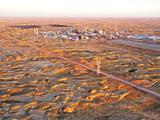China's Domestic Developments: Tech, Trade, and Energy

Technological Innovations and Labor Dynamics in Chinese Firms
The recent announcement by Sina.cn centers around JD.com's bold initiative to enhance delivery operations and employee conditions. JD.com has declared a policy where delivery orders delayed beyond 20 minutes will be free of charge. This move comes in response to competitive practices forcing part-time delivery personnel to choose between companies, termed "二选一" or "choose one of two." In contrast, JD.com is concentrating on hiring full-time workers, increasing recruitment numbers from 50,000 to 100,000, thus providing more job security and stability. This effort is not solely about coping with competition but also about enhancing consumer experience and solidifying a workforce that is not cornered into difficult choices. By emphasizing full-time employment, JD.com is also aligning with broader Chinese labor policies encouraging stable job creation.
The narrative in this story underscores a bid to alleviate tension within gig economy roles, an effort that is emblematic of larger trends in Chinese socio-economic structuring. As China aims to balance rapid technological advancements with stable employment, such policies may well influence labor strategies beyond China, as multinational firms observe these adjustments for potential application in global markets.
Strategic Ambitions Under China's "十四五" Development Goals
In parallel, The Paper explores China's broader economic ambitions under the "十四五" or 14th Five-Year Plan. The publication highlights the drive to complete significant tasks in economic reform and innovation, aiming for a solid opening to the 15th Five-Year Plan period. The language of this report is infused with a narrative of urgency and ambition, indicative of a nation striving to not just meet economic targets but exceed them through strategic localization and global positioning.
Reports mention impressive growth statistics: a 5.4% increase in GDP and a 9.7% growth in high-tech manufacturing value—a reflection of strategic positioning to bolster comprehensive national strength. By calling attention to the "南新北战"—or southern innovation and battle strategy—the publication suggests a diversified regional development approach, reinforcing both local strengths and national integration.
This ambition hooks into a global narrative where China portrays itself not just as a thriving economy but a guiding force in global economic stabilization amidst fluctuating international markets. The positive imagery and the focus on strategic success convey a message of a proactive and adaptable Chinese economic machine, hinting at China's growing influence in dictating future international economic frameworks.
Energy Production as a Backbone of Economic Stability
Simultaneously, an energy narrative unfolds with Sina.cn reporting on the cumulative output of China's largest ultra-deep oil field, the Fuman Oilfield, crossing the 20 million-ton mark. This milestone underscores the nation's prowess in overcoming geological challenges labeled globally as "forbidden zones." By advancing exploration within high-temperature, high-pressure, high-sulfur reserves, China strengthens its energy security, contributing to the larger "energy rice bowl" strategy.
Such developments are not just technical achievements but are woven deeply into national rhetoric portraying innovation and self-sufficiency. As the world pivots towards sustainable energy solutions, China's assertive moves in energy exploration mark significant pressure points within the global energy market. By showcasing formidable technological capabilities, China could influence energy policies and partnerships worldwide, potentially shifting dynamics in global energy alliances.
Massive Infrastructure Developments in China's Technology Sector
Recently, China Electronics Company has been making significant strides in various sectors by winning bids for multiple large-scale projects. A report by Sina highlights China's efforts in achieving high-quality growth and completing annual targets in government administration, agriculture, finance, and other domains. Notably, this involves the deployment of the FTC862 processor cores, demonstrating China’s commitment to developing domestic tech capabilities.
Sina's narrative emphasizes China's strategic advancement in tech sovereignty,** potentially aiming to reduce reliance on foreign technology while highlighting domestic innovation. This could significantly impact global tech markets, creating competitive pressure on international tech giants and influencing global supply chains.
Energy Storage Revolution in Xinjiang
In another article, Xinjiang’s grid has announced advancements in new energy storage, with installations exceeding 10 million kilowatts. This achievement positions Xinjiang at the forefront of energy storage within China, showcasing regional efforts to enhance energy security and efficiency. The narrative points out the challenges of intermittent energy production and the seasonal variability in power supply, which are being addressed through new energy storage technologies.
Xinjiang's developments also reflect China's broader push towards clean energy. This ties into global trends of sustainable energy transitions, potentially influencing energy policy dialogues worldwide and setting examples for regions grappling with similar issues. The focus on sustainable practices might hint at China's growing role as a leader in global environmental solutions.
China Amidst Global Trade Tensions
Lastly, an analysis from The Paper addresses contentious US trade tariffs impacting nations, particularly those in the Global South. The article decries what it terms as "economic neo-colonialism," where unilateral tariff impositions impair economic growth in less-developed countries. The piece paints these measures as disruptive, undermining international trade fairness and exacerbating developmental inequalities.
The critique aligns itself with voices worldwide calling for fair global trade practices and the maintenance of multilateral trade regimes. By positioning China as a leader advocating for equitable economic growth, the narrative crafted here places China on a moral high ground—championing the cause of underrepresented nations. China's vocal criticism of protectionist practices reflects both its commitment to upholding international trade norms and strategically fortifying its image as a progressive global leader in economic equity.
These stories collectively carve out a vivid image of China's domestic strategies and ambitions, showcasing a nation deeply invested in technological, economic, and energy sovereignty, even as it positions itself as a bastion against global economic protectionism. Each move detailed in these stories hints at the ripple effects these policies might have worldwide, sending a clear message of China's ongoing influence and strategic foresight.



